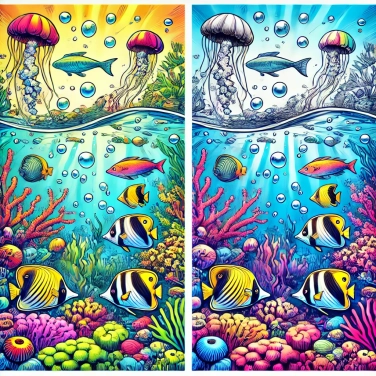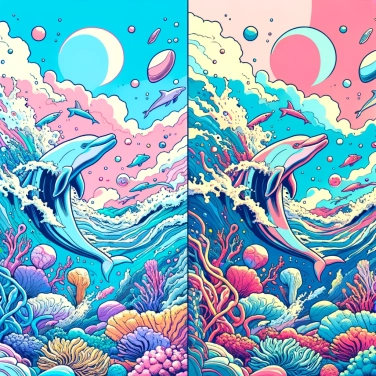Colors appear different underwater because light is filtered and absorbed differently by water, which alters the perception of wavelengths and results in a change of color.

Underwater, sunlight is quickly filtered, and it's certain colors that suffer first. Indeed, water gradually absorbs colors according to their wavelength: first red, then orange, next yellow, while colors like blue and green penetrate more deeply. Specifically, just a few meters below the surface, red turns grayish or disappears completely, leaving red objects dull or barely visible. As you descend deeper, this gradual disappearance of warm colors gives everything a bluish and greenish hue typical of underwater photos. That's why experienced divers often take a lamp or a flashlight with them: it helps to restore some of those lost colors, revealing the true hidden beauty of fish and corals.
When you dive underwater, the light fades quickly, and not all colors do so in the same way. Just a few meters down, the reds begin to disappear, becoming dull and then completely gray. Even lower, the oranges and yellows gradually fade away. Only cool shades like blue or green remain, which persist much further down. That's why, when diving deep, everything seems bathed in a somewhat strange bluish atmosphere. Without artificial light (like a dive light), those warm colors you could clearly see at the surface become unrecognizable in the depths.
When light passes through water, it encounters molecules, microorganisms, or suspended particles. These elements deflect and scatter the light in all directions: this is what is called scattering. This phenomenon is particularly pronounced with short wavelengths, such as blue or violet, which explains why water often has that deep bluish hue you see underwater. Due to these multiple light bounces, subjects gradually lose their vivid and contrasting colors, becoming visually less sharp as they recede. The murkier the water, the stronger the scattering, which is why your underwater photos taken in sediment-laden or algae-filled waters appear blurry and dull.
Underwater, particles and micro-organisms play an important role in the colors we observe. Microscopic algae and plankton absorb and diffuse certain colors, altering the overall hue of the water. There's no need to go far to witness this phenomenon: murky water, laden with sediments like sand or mud, will quickly appear greenish or brownish. Suspended particles also scatter light in all directions, making colors less sharp and contrasts blurrier. Sometimes, the massive presence of certain organisms, like blooming red algae, completely changes the color atmosphere underwater. In short, what you see beneath the surface is directly influenced by the tiny inhabitants and floating dust all around.
Underwater, the human eye is clearly not up to the task. Our vision is designed to function in air, not really immersed. Water alters the trajectory of light, and our cornea nearly loses its focusing power. As a result, we see blurry, unable to properly adjust our vision. Moreover, our ability to perceive colors drastically decreases as we dive deeper. After just a few meters, bright colors like red quickly fade: everything soon appears drawn towards a monotonous blue-gray. Our retina, too, is less sensitive in these low-light aquatic conditions. Not to mention the additional difficulty in clearly distinguishing the contours of an underwater object or quickly spotting peripheral movement. In short, we can get somewhat used to it with enough dives, but without the right equipment, our eyes remain decidedly mediocre underwater.
Professional divers sometimes use special lamps to reveal the true underwater colors, which are often surprising and different from their natural appearance to the naked eye.
The phenomenon of bioluminescence allows various aquatic creatures to produce their own light to communicate, attract mates, or deceive predators.
Underwater photographers generally correct the colors of their photos using specialized filters or editing software, allowing them to display colors that are closer to reality.
Some marine species have developed bright colors that are invisible to most predators, as these colors quickly disappear in the depths.
In general, beyond 20 to 30 meters of depth, most colors gradually disappear, leaving primarily shades of blue and gray. To see the true colors of objects, it is necessary to use artificial light, such as a dive lamp, beyond this limit.
Yes, color vision in fish varies greatly from one species to another. Some fish have a very good perception of colors, even better than that of humans, while others can only perceive certain light spectra. This visual adaptation depends on their habitat, depth of living, and needs for communication or camouflage.
The diving mask creates a layer of air between the diver's eyes and the water, allowing for clearer vision than with the naked eye. Without a mask, the human eye loses its ability to focus properly, resulting in blurred colors and vision. The mask therefore enables a more accurate perception of underwater shapes and colors.
Underwater, colors generally appear duller as one descends deeper. The decrease in light intensity and the specific absorption of colored rays by water lead to a gradual reduction in the brightness and hue of colors.
Divers use a white light because it best restores the entire light spectrum. This allows for the true colors of organisms and underwater objects to be seen, which is essential for better observation and accurate photography.
The color red is the one that disappears the fastest underwater. This is due to the selective absorption of wavelengths by water molecules, which quickly absorb warm colors, leaving blues and greens visible at greater depths.

100% of respondents passed this quiz completely!
Question 1/5